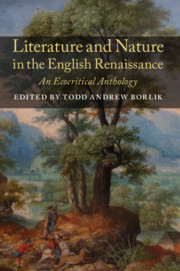Book contents
- Frontmatter
- Contents
- List of Illustrations
- Acknowledgements
- Editorial Principles: Towards the Ecocritical Editing of Renaissance Texts
- Introduction
- PART I Cosmologies
- PART II The Tangled Chain
- PART III Time and Place
- PART IV Interactions
- PART V Environmental Problems in Early Modern England
- PART VI Disaster and Resilience in the Little Ice Age
- Appendix A Industrialization and Environmental Legislation in the Early Anthropocene: A Timeline
- Appendix B Further Reading: A Bibliography of Environmental Scholarship on the English Renaissance
Introduction
Published online by Cambridge University Press: 05 June 2019
- Frontmatter
- Contents
- List of Illustrations
- Acknowledgements
- Editorial Principles: Towards the Ecocritical Editing of Renaissance Texts
- Introduction
- PART I Cosmologies
- PART II The Tangled Chain
- PART III Time and Place
- PART IV Interactions
- PART V Environmental Problems in Early Modern England
- PART VI Disaster and Resilience in the Little Ice Age
- Appendix A Industrialization and Environmental Legislation in the Early Anthropocene: A Timeline
- Appendix B Further Reading: A Bibliography of Environmental Scholarship on the English Renaissance
Summary
Observing the population levels of 7,964 native species and cross-referencing the results with a Biodiversity Intactness Index, conservationists have pronounced the United Kingdom to be one of the most “nature-depleted countries in the world.”1 Not coincidentally, it also has the dubious distinction of being among the least forested in Europe: its 13 per cent wood cover (10 per cent in England) barely amounts to a third of the EU average of 38 per cent.2 Since conservation biology trades in hard statistics gleaned from consistent observation, the 2016 State of Nature Report defines “long term” as the past forty years. But Britain was not de-wilded in a few decades. It has been a centuries-long saga, one of the most eventful chapters of which coincides with the great cultural flowering known as the Renaissance.
Despite the fact forty years is an eyeblink in geological terms, ecocriticism has tended to patrol a narrow strip of the recent past. While this is in part due to an admirable concern for the here and now, it also results from a myopia induced by crude narratives in cultural and environmental history. Surely, before Wordsworth gazed down upon the Wye Valley no one bothered to peer “into the life of things.” Prior to Darwin's Origin of Species, humans fancied themselves the god-like overlords of creation. Only after the Industrial Revolution and post-war pesticides endangered it did the environment come into focus as a realm in need of protection. While puncturing such blithe assumptions is one of the objectives of this book, it has become abundantly clear that environmental criticism need not – and indeed should not – confine itself to anthems to a green and pleasant land. It bears remembering that the picturesque landscapes around Tintern Abbey and the Lake District that so enraptured Wordsworth were wrought by deforestation from ironworks and charcoal-making, and that much of the worst damage occurred in the sixteenth century.3 The commitment of second-wave ecocritics to move “beyond nature writing” has given wings to a chronological leap beyond the contemporary and Romantic eras into earlier periods when prevailing attitudes towards the natural world were, by and large, not so eco-friendly but which demand all the more scrutiny by virtue of their difference.
- Type
- Chapter
- Information
- Literature and Nature in the English RenaissanceAn Ecocritical Anthology, pp. 1 - 24Publisher: Cambridge University PressPrint publication year: 2019



